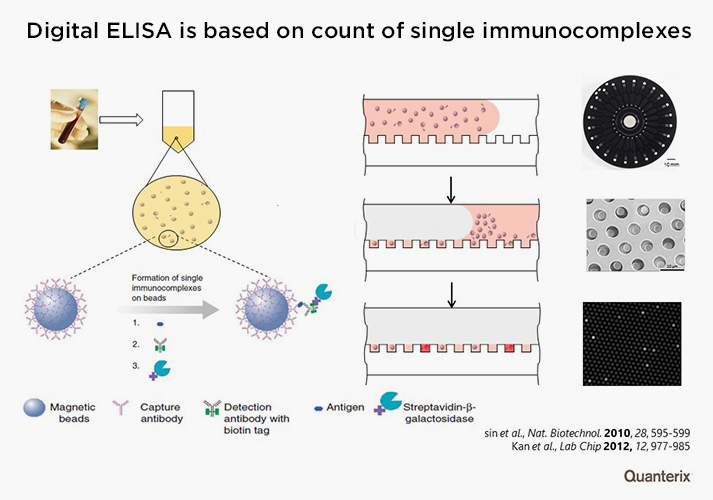Instrumentation
The Proteomics & Metabolomics Core provides state-of-the-art enzyme-linked immunosorbent assay (ELISA) quantification for protein quantification as a collaborative service.
The core assists in study design and choice of existing commercial single and multiplex ELISA assays and/or developing new ELISAs. ELISAs can be used to quantify one or more proteins simultaneously in serum, plasma and other body fluids, as well as in cell and tissue lysates.
The core also carries out aliquoting, processing samples, running samples, and analyzing and reporting data. All assays are run in duplicate. Quality controls embedded in the method ensure that all assays are repeated if sufficient samples show a coefficient variant percentage (%CV) greater than 20%.

Simoa® HD-1 Analyzer
Quanterix's Simoa HD-1 Analyzer is a fully automated immunoassay platform with unprecedented ultra-sensitivity. Single molecule array (Simoa) testing can achieve quantitative biomarker analysis with sensitivity into the femtogram (fg/ml) range, representing up to 1,000 times higher sensitivity than traditional enzyme-linked immunosorbent assay (ELISA).
How Simoa Technology Works
The main difference between Simoa and conventional immunoassays is in its ability to trap single molecules in femtoliter-sized wells, allowing for a digital readout.
This enhanced detection platform makes Simoa the premier choice for the quantitative detection of low-abundant and difficult-to-measure biomarkers where high sensitivity is an advantage.
- Single protein molecules are captured and labeled on beads using standard ELISA reagents.
- Tens of thousands of beads, with or without immunoconjugate, are mixed with enzyme substrate and loaded into individual femtoliter-sized wells that are engineered to house an individual bead.
- The microwells are sealed with oil.
- Fluorophore concentration in the small sample volume of wells containing the target analyte rapidly reach detectable limits using conventional fluorescence imaging which can be digitally counted.
- The percentage of beads containing labeled immunocomplexes can be computed at low concentration because they follow a Poisson distribution: at higher concentrations, the intensity of the aggregate signal provides an analog measurement.
Sample requirement
Volume approximately 50–60 uL/assay for analysis of plasma, serum, central system fluid (cerebrospinal fluid, CSF), etc. Each assay must be carried out in duplicate and must achieve a %CV below 20 percent.
MESO QuickPlex SQ 120
The MESO QuickPlex SQ 120, a Meso Scale Discovery (MSD) platform, is the newest system from MSD. The MSD technology employs specific and accurate antibody arrays in a single well of a 96-well plate for maximizing available space for multiplexing and uses novel electrochemiluminescence for detection, which reduces background and enhances the dynamic range of the signals.
This high-performance multiplexing makes MSD the premier choice for accurate measurements of up to 10 analytes at a time within the same sample.
How MSD Technology Works
The MSD system applies electricity to plate electrodes, which leads to emission of light by SULFO-TAG labels conjugated to detection antibodies. Measurement of the light intensity corresponds to the amount of target analytes in the sample.
Advantages of MSD include:
- Small sample volumes, multiplexing, high throughput
- High sensitivity, large dynamic range, high precision
- Low background, simple protocols, reduced matrix effects
The assay menus are constantly updated by the manufacturers. Please refer to the list of Meso Scale Assay Kits.
Sample requirement
Volume approximately 10–50 uL/assay for analysis of plasma, serum, CSF, cell culture supernatant, cell lysate, etc. Each assay is carried out in duplicate and must achieve a %CV below 20%.
Have Questions or Need Help?
Contact us if you have questions or would like to learn more about the Proteomics & Metabolomics Core at Cedars-Sinai.
